Have you ever wished you could give your old interior doors a facelift? I wanted a fresh look on all of my interior doors throughout the house. So, I decided to give my 1970s hollow core doors a much-needed upgrade using a simple technique. Follow along to learn how to upgrade interior doors in your house too. You will be amazed at what some pieces of trim, paint, and a new doorknob can do!
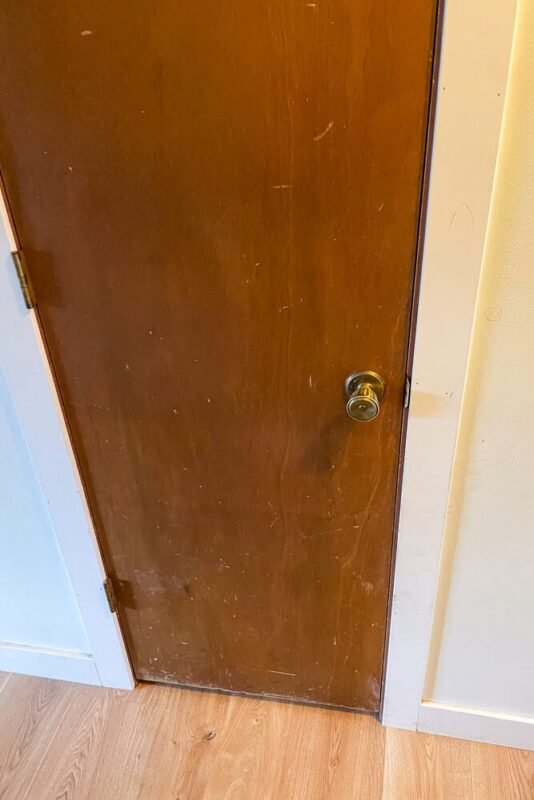
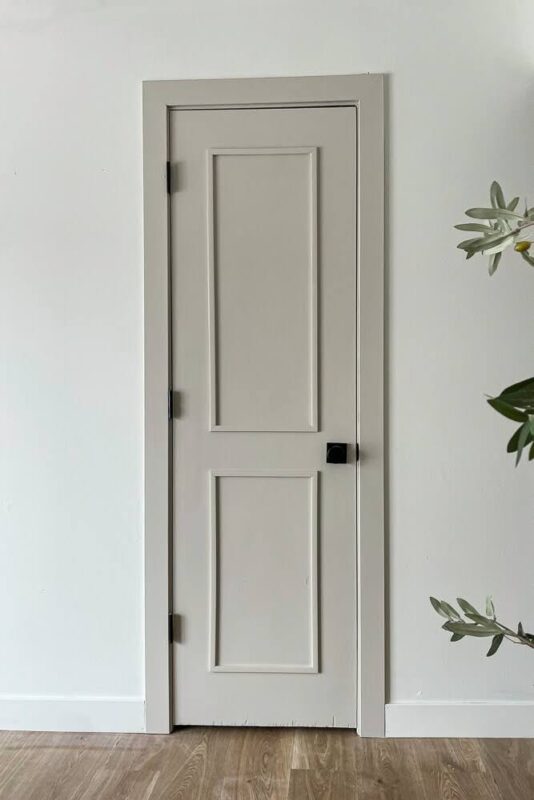
Supply List
Trim Puller
Hammer
Brad Nailer
Brad Nails – 5/8″
Tape Measure
Miter Sheers
Handheld Electric Sander
Milwaukee Drill Combo Set
Small Level
Painters Tape
Black Rust-Oleum Satin Paint and Primer
White Primer Ultimate Stain Blocker
Caulk
Caulking Gun
Dap DryDex Spackling
Wood Filler
Bondo
Small Paintbrush
Mini Paint Roller
Door Knob
Trim
Paint-Accessible Beige by Sherwin Williams
Preparing for the Closet Door Makeover
My closet door had a mirror on the inside of it and I wanted to take it off completely. That was quite the undertaking! After one attempt with the trim puller, I decided to tape up the mirror to prevent it from shattering while trying to take it off. I used painter’s tape to tape it up in multiple directions so that when it was pulled off, the tape would support the mirror and it wouldn’t break as much, if at all.
Then, I decided to bring in my hammer and tap the trim puller slowly and carefully behind the glass mirror to separate the mirror from the door. It turns out 5 sticky adhesive squares were holding each section of the mirror up onto the door! The mirror did end up breaking a tad, so I am glad I taped it up quite a bit.
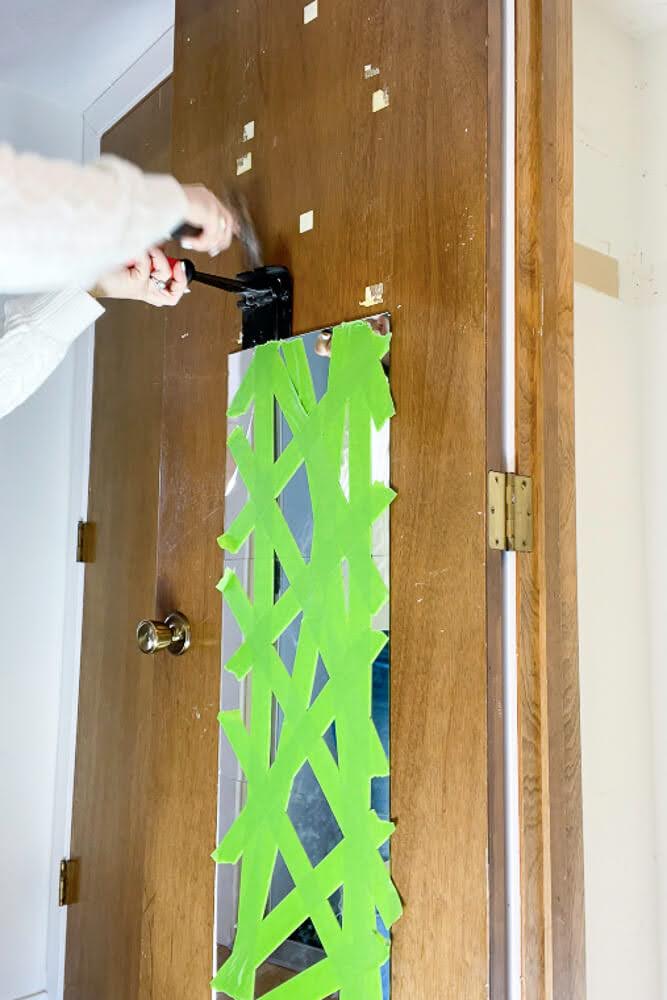
Next, I had to figure out how to get all the adhesive squares off. I tried using just a piece of sanding paper, which did not fly, my electric handheld sander, and then some lemon essential oil. Ultimately, the electric handheld sander worked the best, so I stuck with that. It worked even better when I used a fresh piece of 150 grit sandpaper on it.
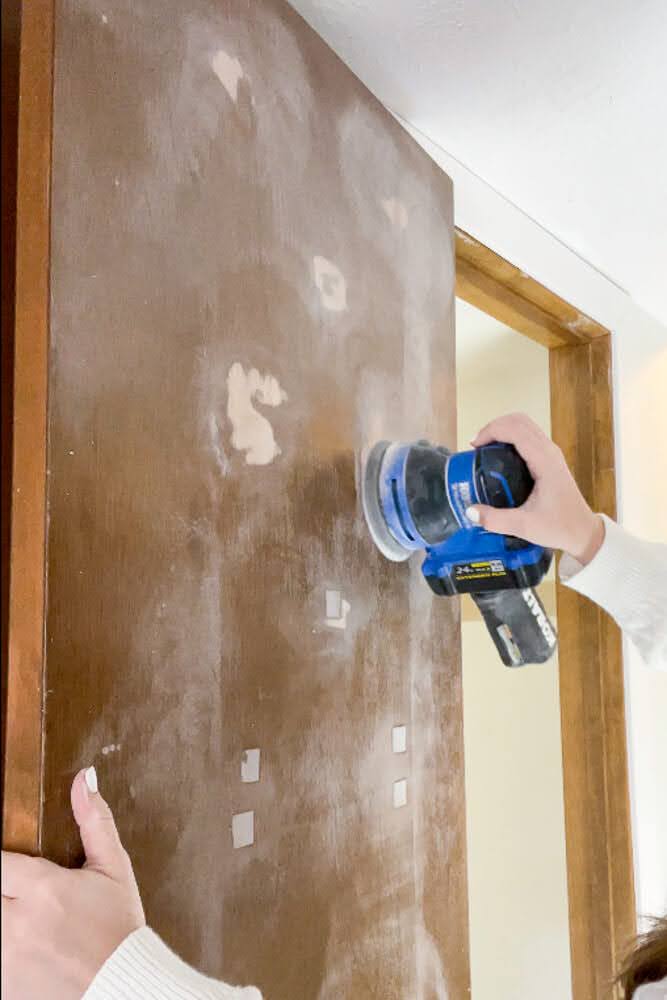
I used a damp cloth to wipe off any dust left from sanding on both sides of the door and took the doorknob and mechanism out of the door.
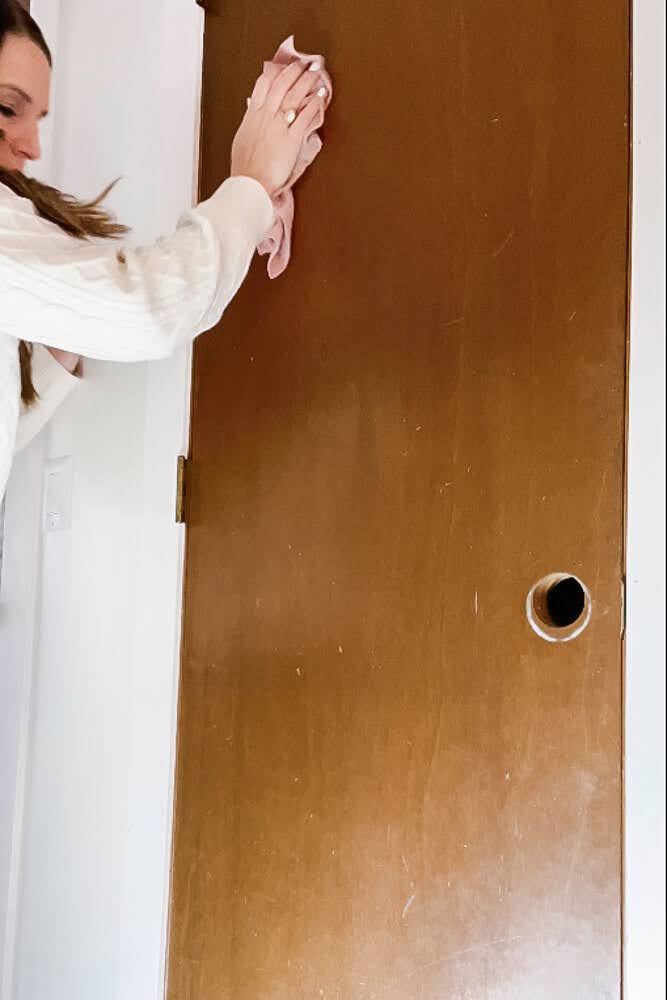
Painting Hinges to Upgrade Interior Doors
It is SO easy to upgrade interior doors just by simply spray painting the hinges with a modern color. All of my door hinges were gold in this house and I chose to paint them black with this simple method!
First, I used painter’s tape to tape around each hinge. Then, I took a small piece of cardboard to help contain and deflect any paint while spraying each hinge with black Rust-Oleum Satin Paint and Primer in One. Voi la! New hinges in a matter of seconds!
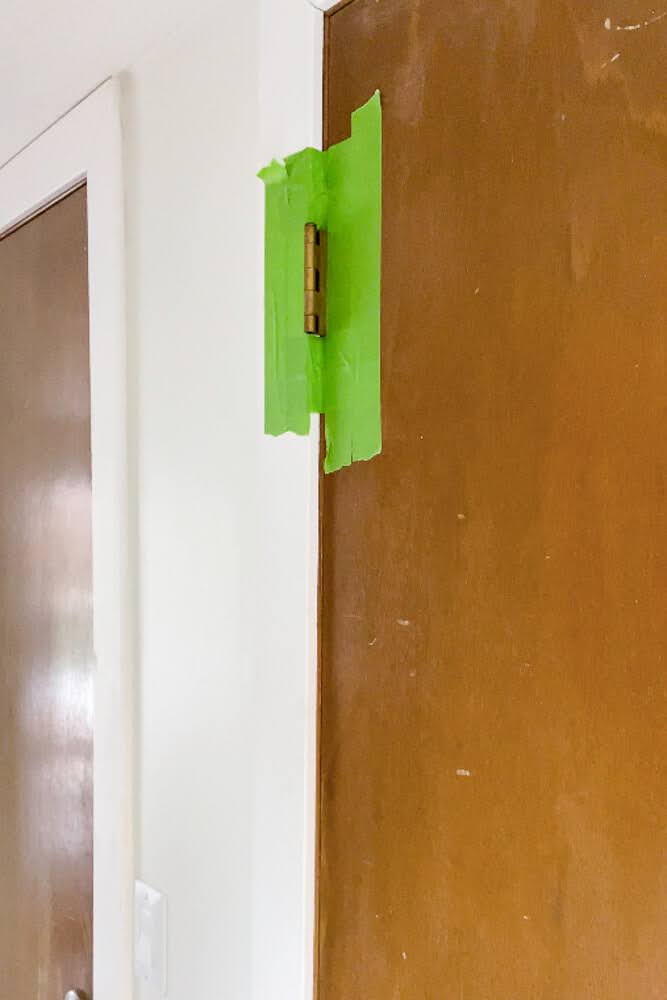
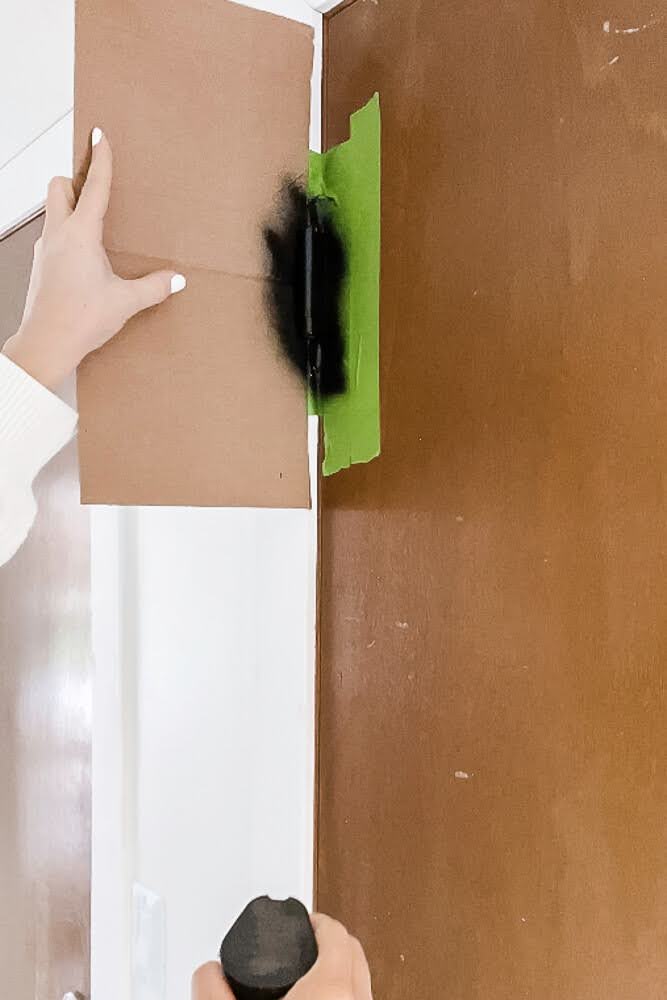
Priming for the DIY Door Makeover
After the hinges were dry, I used a white primer to paint the door and door frame. My small paintbrush was used for the areas around each hinge and the creases of the frame. For the actual door, I used my mini paint roller, which covers more surface area than my paintbrush, making painting the door quicker. It also leaves it with a better finish, so I used it to back roll over any place I needed to use a brush. BUT, since this is just a primer, it does not have to be perfect.
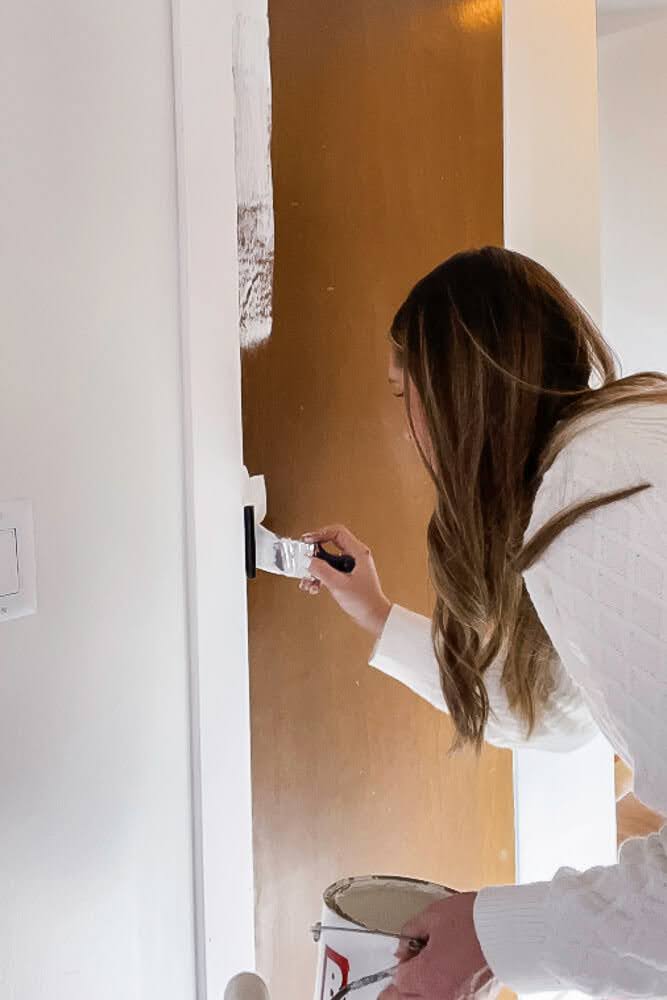
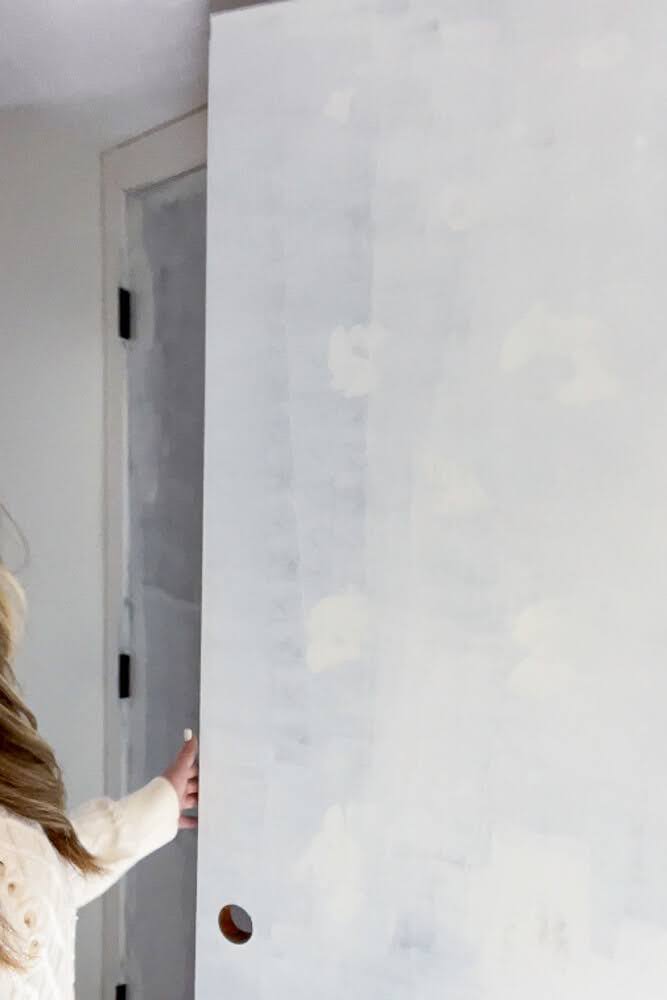
Measuring for the Trim to This DIY Door Upgrade!
After the primer was completely dry on both sides of the door and door frame, I needed to figure out all the measurements and mark where I wanted my trim to be placed on the door.
For my particular door, I wanted two square frames on it. One on the upper half of the door and one on the lower half of the door, although I like the look of the top frame being larger than the bottom. But really, there’s no wrong way to do it.
I first measured the top square by measuring 5 inches from the top of the door to the center and marked it with a pencil, then measured 5 inches from the left side to the center and marked it, and 5 inches from the right side of the door to the center and marked it. That’s where my trim pieces were placed once cut to size.
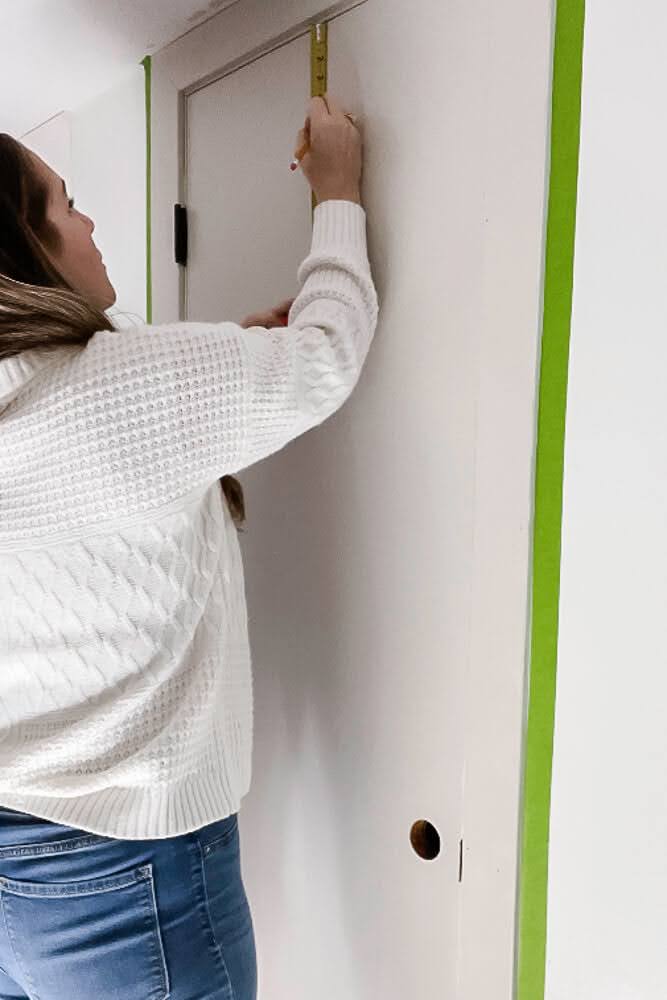
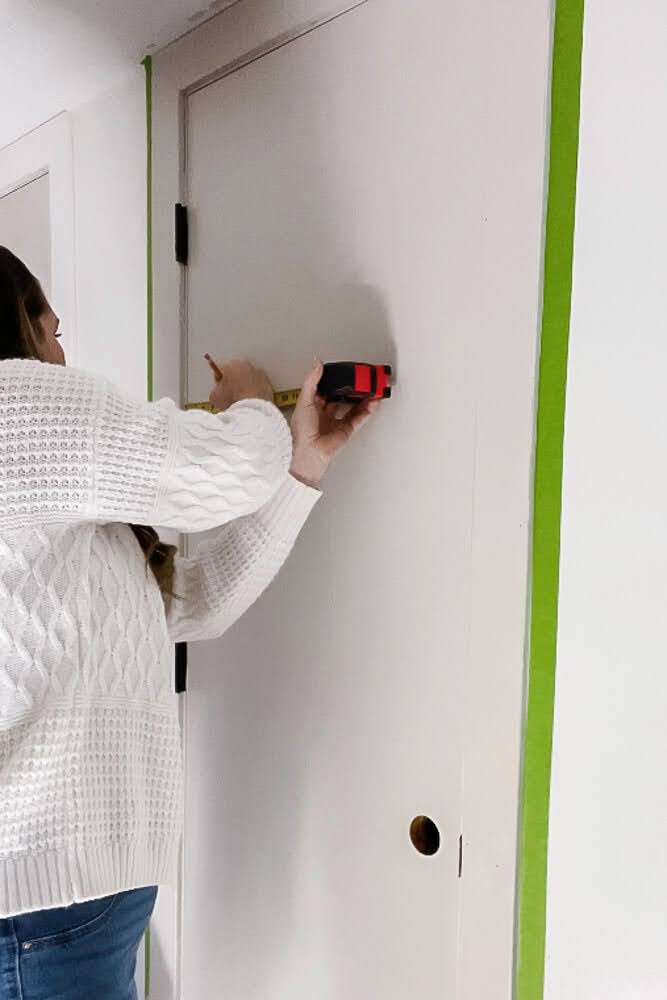
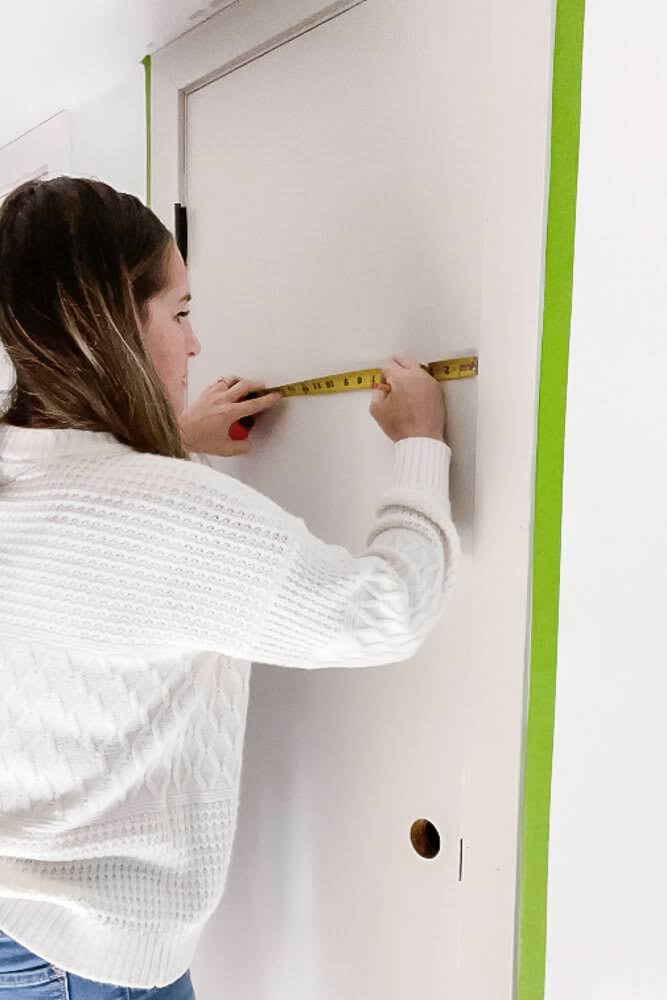
The exact height of the boxes will be totally dependent on how tall your doors are, and how tall you want your boxes to be, but my top box measured 36 1/4 inches in length. Once that was determined, I placed my tape measure on my 5-inch mark at the top of the frame, measured 36 1/4 inches down the center of the door, and marked it again. The new mark is where the bottom of the box will lie.
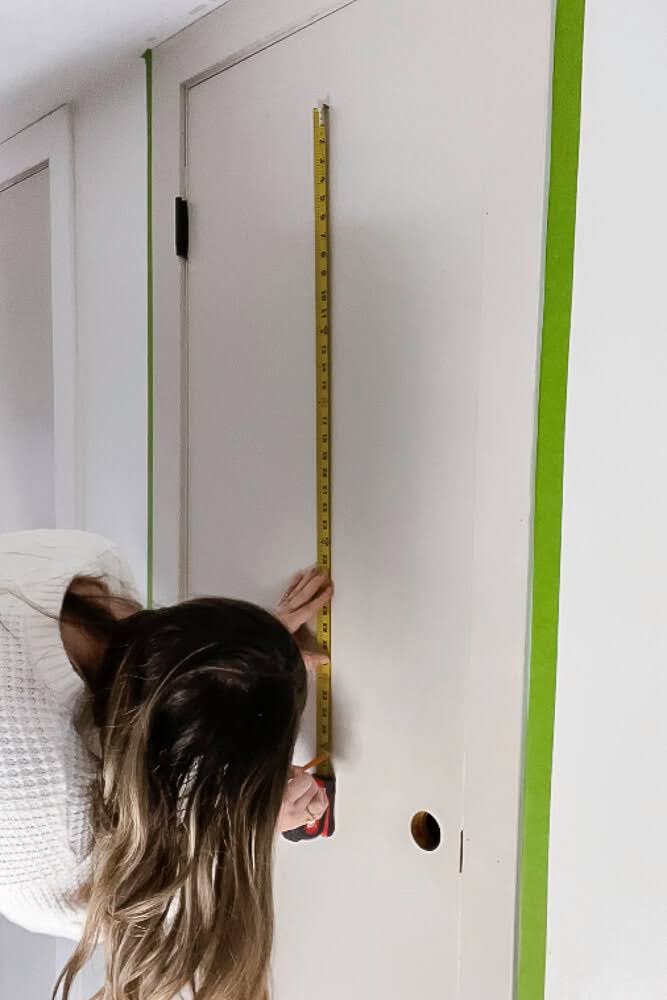
From that new mark on the bottom of the upper square frame, I measured 5 inches down and marked to where I wanted the top of my lower square frame to start. I wanted there to be a 5 inch gap between the two boxes, and I tried to center it with my door knob.
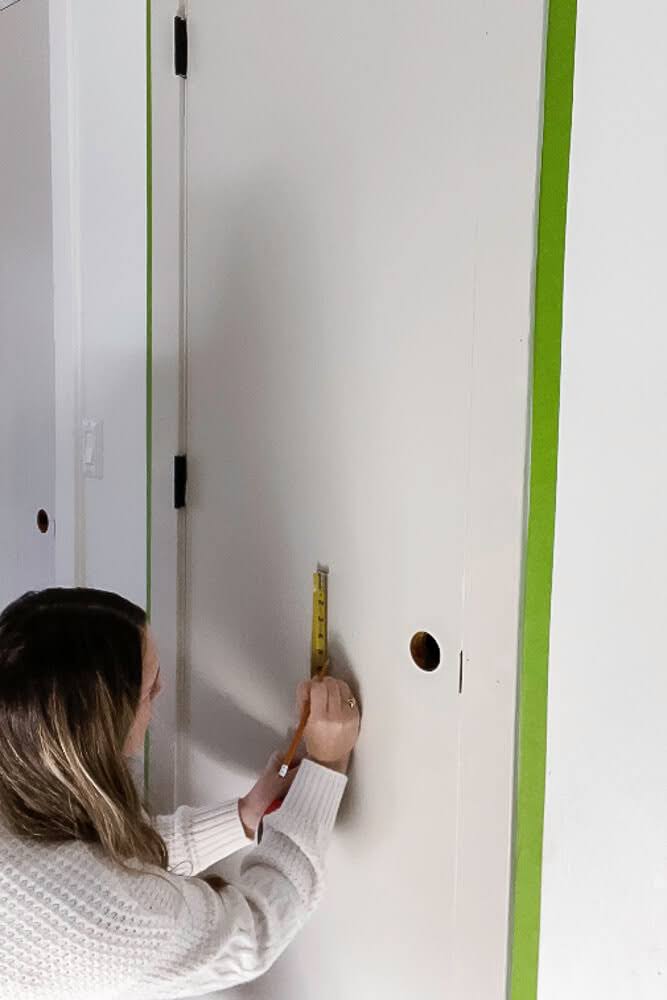
I used most of the same measurements for the lower square frame, except that the bottom box is shorter. I measured 5 inches from the left side of the door into the center and 5 inches from the right side into the center.
To figure out what length the top and bottom pieces of trim needed to be for both of my square frames, I measured from the left 5-inch mark to the right 5-inch mark, which came out to 14 inches.
The measurements came out to be 5 inches from the top frame, 5 inches from each side of the door, and 7 inches from the bottom of the door up to the center. Then, the top and bottom trim were measured to 14 inches and the two sides of the lower frame were measured to be 26 ¼ inches.
Cutting the Trim to Size and Nailing it to the Door
Next, I needed to cut the trim to make both square frames on the door. I picked up this trim from Lowe’s and used my miter sheers to cut each of the pieces.
The miter sheers were set at a 45-degree angle. So, I cut the very end of the trim and then measured it down to 36 ¼ inches and cut another angle at that mark.
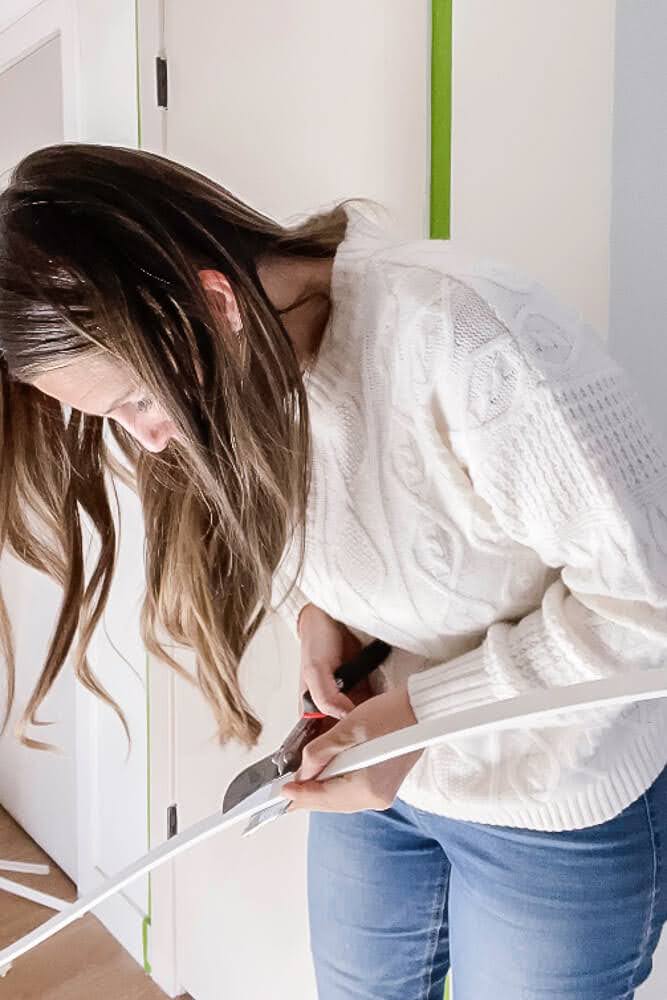
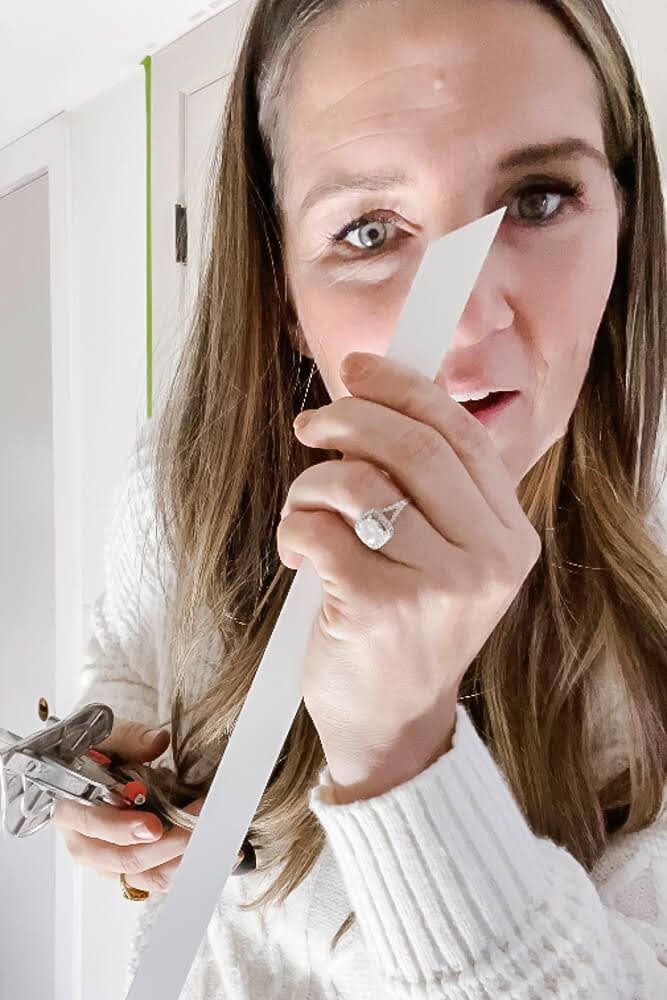
The other end of the trim needs to be cut at an opposite angle as the first end that was cut, but still at a 45-degree angle. So, make sure you switch the angle of the miter sheers so they cut in the opposite direction as the last cut. I needed two pieces of trim cut this way.
Then, I needed to cut 4 pieces of trim the same length as the distance between both of the 5-inch marks that I made from each side of the door. On my particular size door, that distance was 14 inches between both of my 5-inch marks, so I needed to cut 4 pieces of trim 14 inches so I could make two framed boxes on the door.
Once my 4 pieces of trim were cut to 14 inches, I put my tape measure up to the center 5-inch mark on the door and measured the 5 inches into that mark from each side of the door, so I knew where to put my first 14-inch piece of trim.
Because my door is a hollow core door and not solid wood and the trim is very lightweight, I used my brad nailer to nail the trim pieces onto the door. If you are really worried about your trim staying up, you could also apply glue to your trim, but I was not worried about the trim for this door. I used 5/8 of an inch brad nails, very very short!
The first piece of trim went up at the top of the upper square frame with one brad nail right in the center of the trim. Then I took a small level and ensured it was straight before putting more brad nails into that trim piece.
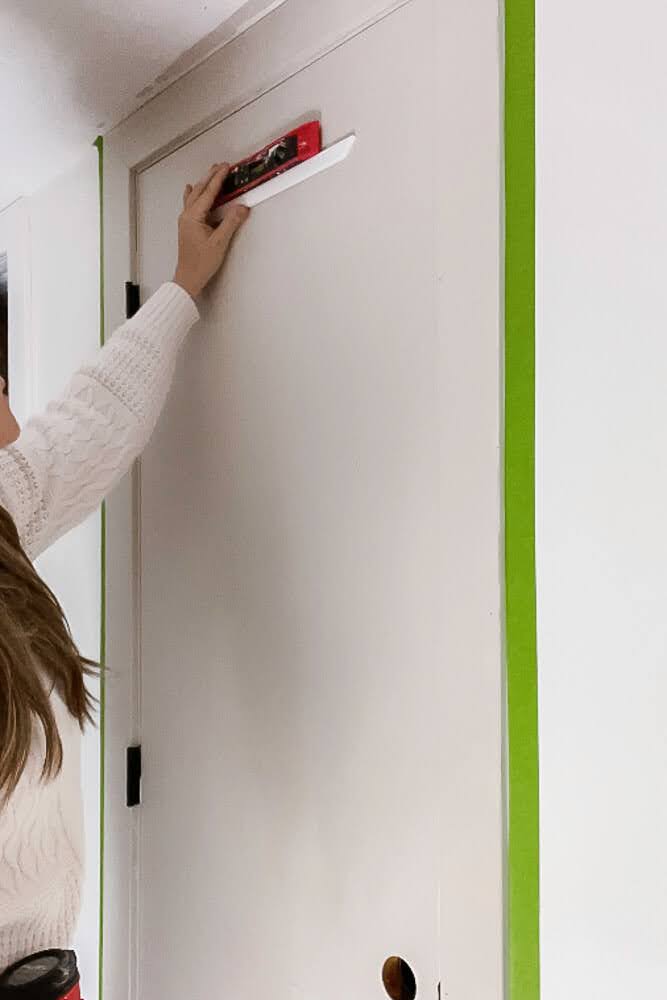
The next piece that I put on was a side piece. For this one, I lined it up with the top piece and only put in one brad nail. I put more brad nails in after the rest of the trim went up because I wanted all the trim pieces to form a square frame and have all the corners meet nicely. Once all pieces were held on with one brad nail in each, I took my level around all of the pieces to make sure everything was level and squared up, then inserted more brad nails in all pieces to secure them better.
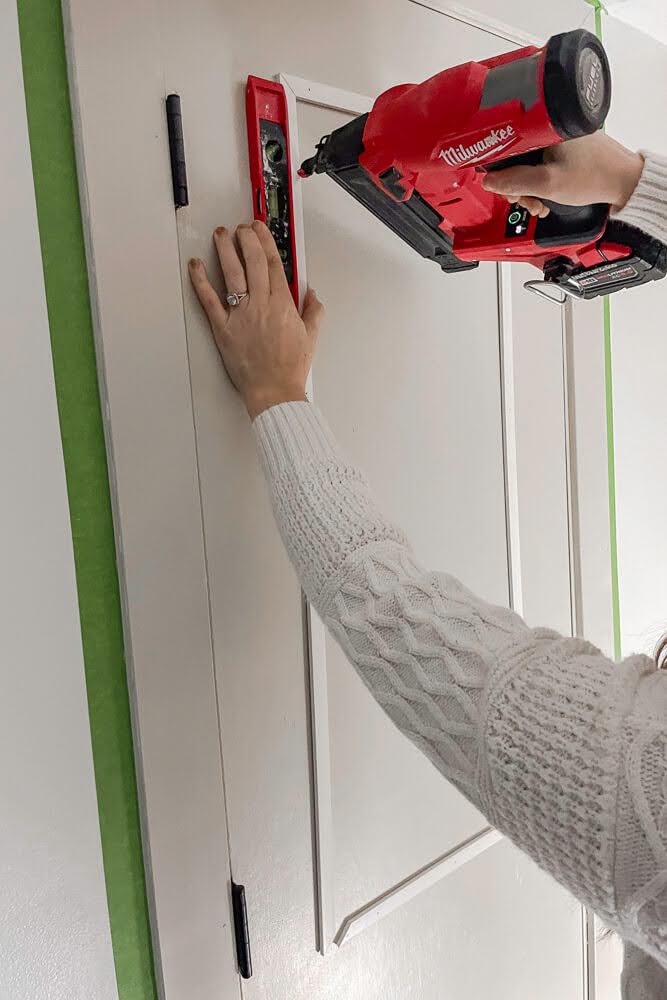
Next, I worked on the lower frame and the sides were 26 ¼ inches long. So, I cut two pieces to that length for my sides and then used two of the pieces that I previously cut to 14 inches for the top and bottom of the square frame. Again, I put my first piece on, which is the top, with one brad nail and then made sure it was level before putting in more brad nails, then I put the other three pieces on with one brad nail, made sure their corners met up with the other pieces and leveled them, before inserting more brad nails.
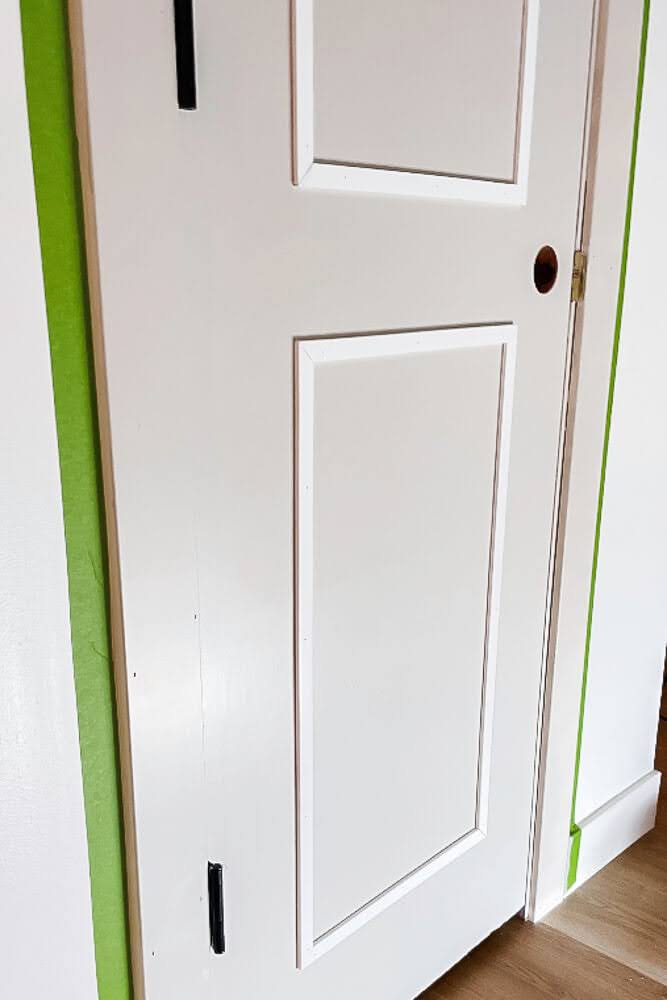
Caulking Around the Trim of the Closet Door Makeover
After all of the trim was put up and in place, I needed to caulk the seams between the trim and the door. When I caulk, I cut a really small angle on the caulking tube. Cutting it at an angle keeps the caulk contained and doesn’t allow too much to come out at a time. Then, I go over the caulk with a baby wipe and then a clean finger. Clean up any excess with another baby wipe. This process can be so easy, that your kids can help out with it!
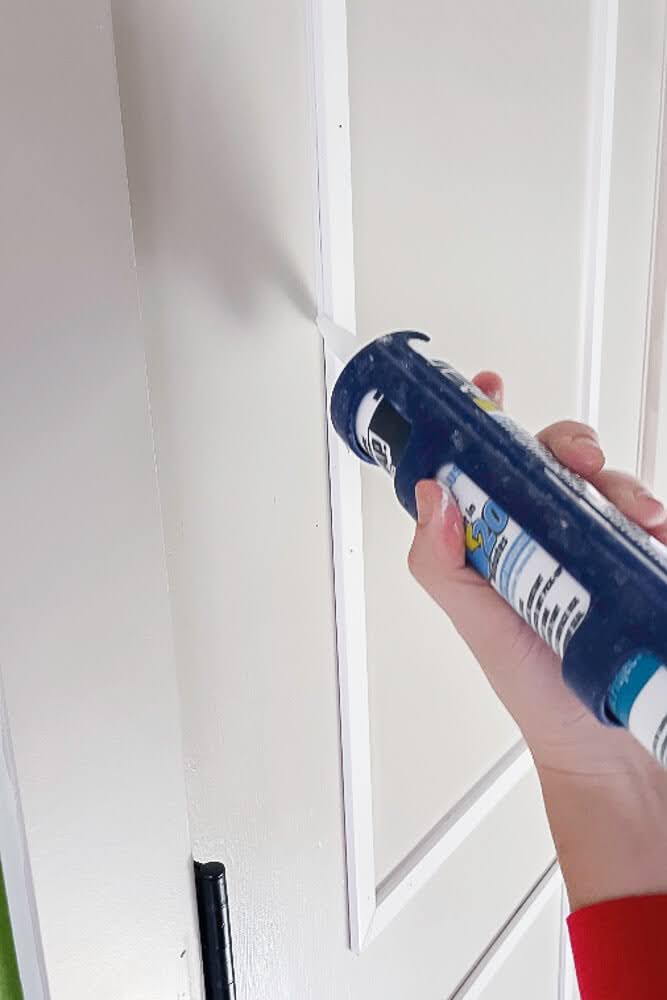
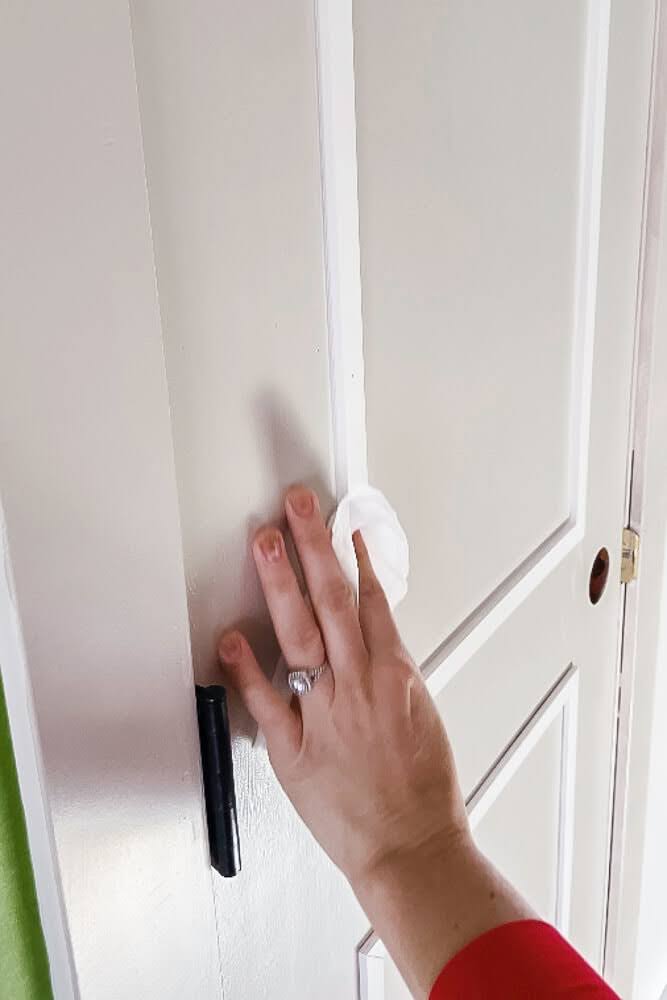
Filling in Holes and Seams
To fill in the brad nail holes and anything on the front flat part of the trim, I used Dap DryDex Spackling. Spackling is not ideal for this kind of thing, it’s more for filling in holes on drywall. I prefer to use this mostly because I can be a little bit lazy, but it also doesn’t shrink terribly like caulk would, especially in teeny tiny holes. It can also be wiped off clean with a sponge when it’s still wet. You don’t have to wait for it to dry and you don’t have to sand it and get the messy dust that wood filler would give.
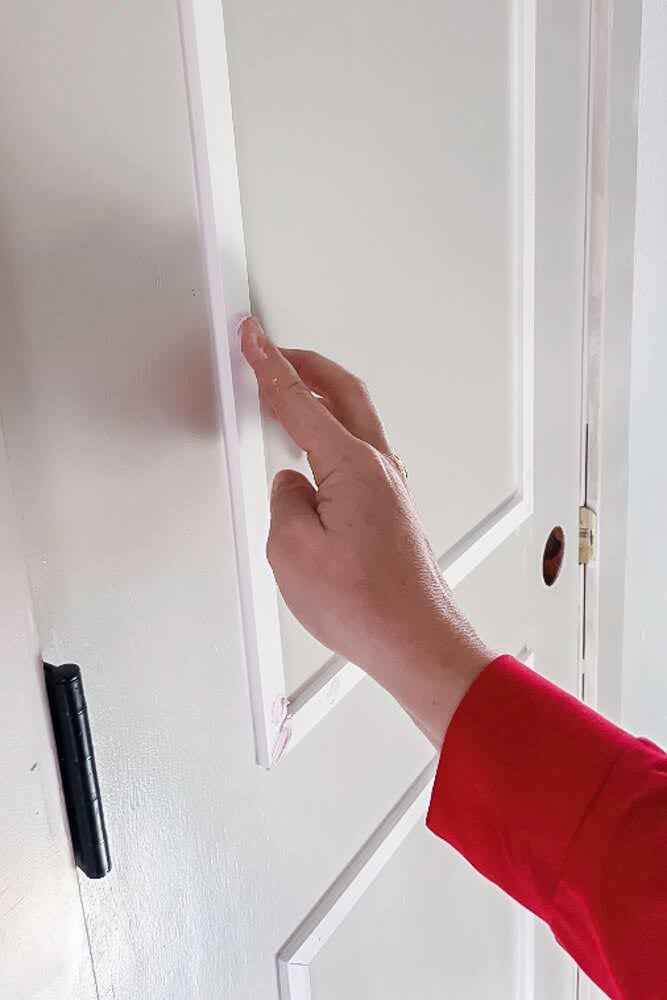
However, your next best option would be using wood filler. You fill in all the flat surfaces with wood filler or spackle (in my case) where the brad nails were put in and the seams are to make it look like one solid piece of wood frame.
So, for anything that needs to be filled on the flat surfaces like nail holes or butt joints, use wood filler or spackle. If you use wood filler, you do have to wait for it to dry, you do have to sand it down, and it does shrink.
If this is a long-term solution for you or you’re working with higher-quality doors, then the best thing to use is Bondo, which is a two-part system. It dries really hard and it sands nicely. You can really hide any imperfections with Bondo. However, it is more work, it’s stinky, it’s more expensive, you have to wait for it to dry, and then you have to sand and dust will get everywhere, so you need to be prepared for that.
I am not really concerned about using Spackle because these doors are not going to be here forever. These are 70’s hollow core doors and they are not great quality. This is just a temporary fix, so I am not too worried about it.
After filling in all the holes and making sure they were smoothed out, I painted the door using the Accessible Beige paint color by Sherwin Williams. Then, a new doorknob and mechanism were installed.
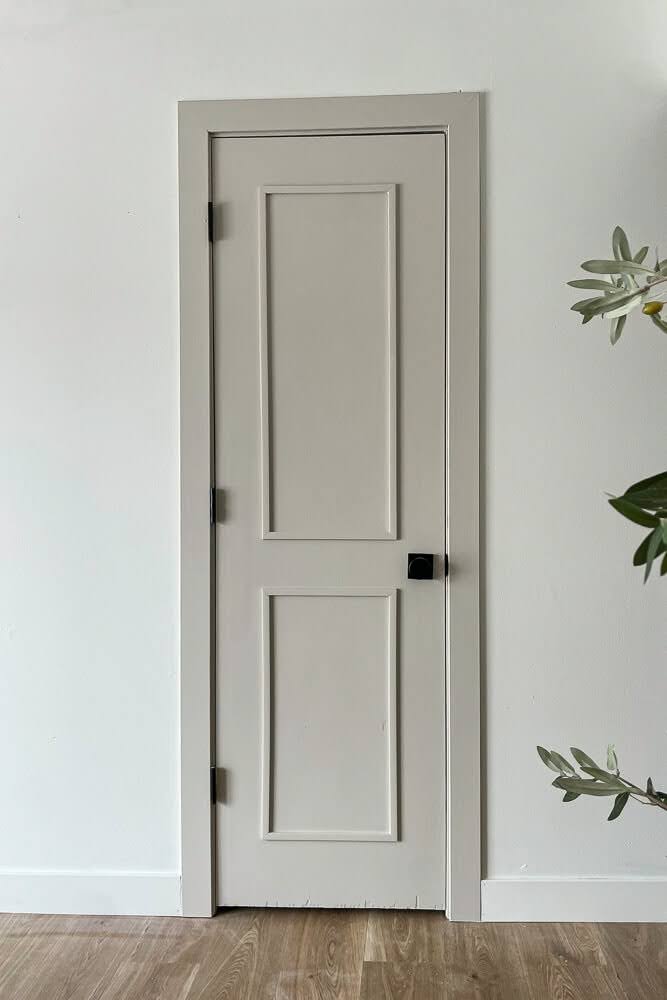
This DIY door makeover is a really simple and affordable way to upgrade interior doors throughout your home. I have done this process on my hallway doors and my closet door makeover as well!
Thanks for checking out the steps I did to upgrade interior doors throughout my house! Are you interested in seeing how I turned my worn-out and dysfunctional coat closet into an aesthetically pleasing and functional coat closet? Look no further! Check out all the steps I took to upgrade my coat closet!

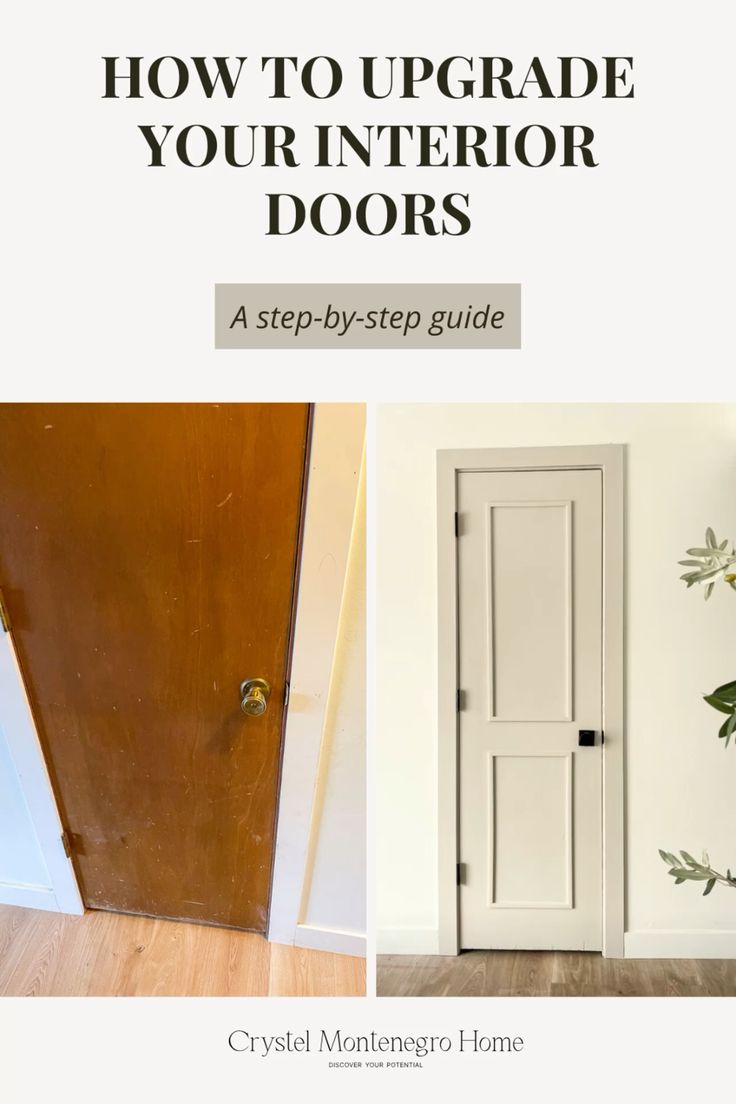
Nice. Another way is to pre-assemble the rectangle on a flat surface, using glue on corners, then stick the rectangle to the door using glue and thin nails.
That’s a great suggestion! I’ve got more doors I can try that on